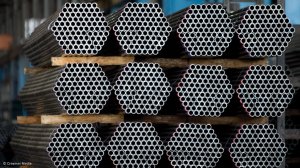Following its initial forecast of a 1.1% expansion of the metals and engineering cluster at the beginning of the year, the Steel and Engineering Industries Federation of Southern Africa (Seifsa) says upon review, preliminary data now suggest a 1.7% expansion of the sector, with all subindustries expected to grow to various levels in 2018.
This is based on structural factors underpinned by a weaker rand that is beneficial for exports amid improving regional and global demand and firmer international commodity prices for steel and engineering products. “The South African metals and engineering sectors have been struggling to improve production owing to capacity underutilisation, poor productivity, un-competitiveness and the lack of local demand. Despite heightened prospects of a trade war, which has the potential to disrupt an otherwise positive global outlook, the current improving global demand and commodity prices hold a great deal of export potential for the sector and this can have a positive effect on the industry,” says Seifsa chief economist Dr Michael Ade.
He mentions that there was an increase in production in the metals and engineering cluster of 2.7% last year. Seifsa is optimistic about this increase because the last time the sector performed well was in 2011. “We are hoping this trend will continue for the remainder of 2018,” Ade enthuses.
To further support this growth, Ade encourages government and industry to cooperate in effectively managing logistics costs, reducing production costs, exploring new markets and, over time, increasing profit margins.
He adds that taking steps would improve investor confidence and the competitiveness of the sector, such as quickly finalising the Mining Charter, thereby creating clarity for investors, as the metals and engineering cluster is highly dependent on the mining sector, which sources about 41% of its inputs from the cluster. Ade also suggests rational energy price regulation, the promotion of competition in electricity generation, transmission and distribution and regulating the price of key inputs to steel products from sole suppliers, to the benefit of the broader steel industry.
Further, in terms of fiscal policy, the Section 12i incentive should be recapitalised, Ade avers, and a 15% tax rate for special economic zones and industrial areas should be implemented to further stimulate growth. To increase the skills offerings of manufacturers, the work permit process should be eased for potential employees that possess skills that are scarce locally.
Ade tells Engineering News that, while the Southern African Development Community is a prime export destination that could prove beneficial for South Africa, there is potential to export into other African regions. Also, addressing constraints to logistics costs can enable the broader steel industry, which is the largest employer in the metals and engineering cluster, to benefit from doing business with lucrative markets in the rest of the world.
Citing a World Bank report which listed Ethiopia, Rwanda, Madagascar, Tanzania, Côte d’Ivoire, Djibouti, Senegal and Ghana as potential markets whose gross domestic product is set to grow by more than 5%, Ade believes the broader steel industry can capitalise on the structural shifts in the industry to increase exports.
This is reinforced by the fact that, after 2009, Africa became South Africa’s prime export destination for the metals and engineering sector. “Before the financial crisis in 2009, Europe was the top export destination for the sector,” Ade highlights.
Since then, he notes that exports into Africa and Asia have increased, while exports to Europe have decreased. This structural change in exports was a reaction to efforts to reduce costs and exposure to exchange rate volatility.
Industry Concerns
Globally, there has been an uptick in the production and consumption of steel, but this has not applied to the South African market, which is of concern to Seifsa and its members.
Additionally, commodity prices are increasing, which has had a knock-on effect on steel prices. “We would expect the sector to benefit from these dynamics, but this is not the case, due to low domestic demand, constraints affecting the supply of inputs and a higher than proportionate increase in local production costs,” Ade points out.
The underuse of capacity has resulted in rising unit costs of production, clogged productive efficiency, wasteful capacity expenditure and the acceleration of wear and tear. This affects the management of inventories, or net operating surpluses and, therefore, profit margins in the industry.
Further, remuneration to employees has consistently increased since 2006, while productivity has not increased proportionately to this; it has rather generally been decreasing for the past five years.
“With net operating surpluses (a wider proxy for profit margin) decreasing and remuneration and variable costs increasing, this does not make the sector attractive, accounting for the current low levels of investments, further hampering operations,” Ade concludes.
Edited by: Zandile Mavuso
Creamer Media Senior Deputy Editor: Features
EMAIL THIS ARTICLE SAVE THIS ARTICLE
ARTICLE ENQUIRY
To subscribe email subscriptions@creamermedia.co.za or click here
To advertise email advertising@creamermedia.co.za or click here















